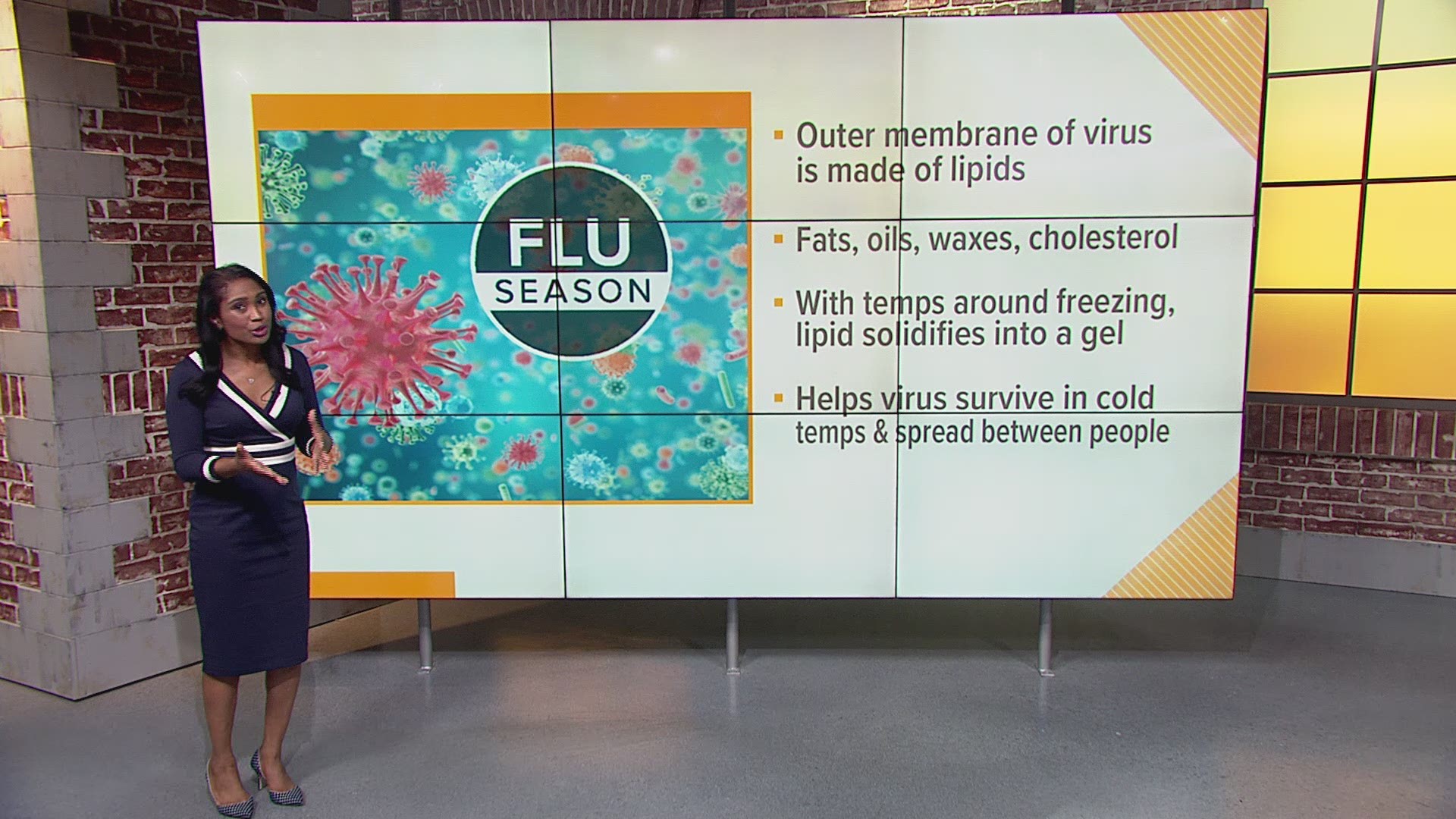WASHINGTON — As the weather gets colder, the flu virus tends to be more active in the U.S. While weather isn't the main driver of the flu, temperature and humidity play a role.
The Centers For Disease Control and Prevention noted that flu viruses can be detected all year long. For the U.S., seasonal flu activity often starts around October or November and peaks between December and February.
So what's the winter connection? The flu virus seems to be fortified in colder temperatures, according to research done by the National Institutes of Health.
TEMPERATURE
It's almost as if the cold has given the virus a protective coat. The outer membrane of the influenza virus is made of lipids which include fats, oils, waxes and cholesterol. These lipids don't mix well with water. Researchers found that the lipid covering solidifies into a gel at temperatures slightly above or below 32 degrees.
Researchers think that the outer-coat in gel form helps the virus survive in cooler temperatures and spread from person to person. Once in the respiratory tract, the body's warmth causes the covering to melt, allowing the virus to infect a person's cells.
At 70 degrees, the lipid covering is still in gel form. At above 70 degrees, the gel starts to melt into a liquid phase. Researchers believe the liquid phase doesn't protect the virus against the elements, causing the virus to lose some of its ability to spread in warm air. NIH experts note that as the weather gets warmer, the flu viruses dry out and weaken.
This has been noticed about the flu in America. It should be noted that in tropical climates, the flu also spreads where it's typically warm and humid.
HUMIDITY
Turning on a humidifier in the winter not only combats dry air, but it could also help ward off the flu. The flu isn't a fan of humidity. The virus works best in dry air. A study in PLOS ONE noted that at higher humidity, the virus loses its ability to be as infectious. This study observed coughing as a way to spread the virus. With relative humidity set at 45%, researchers noticed that 52% of the virus lost infectivity, or the ability of a pathogen to cause infection.
Lower humidity may impact how our bodies are able to defend ourselves against the flu. A study in the National Academy of Sciences found that exposure to dry air may impede the Mucociliary clearance function. Science Direct defines the MMC function as a, "critical and physiologically regulated protective function of the airways and lungs that is essential for the clearance of respiratory pathogens."
Researchers said that it loses some of its ability to clear pathogens.
Yes, you can use a hygrometer to help monitor the humidity levels in your home, but that's based on relative humidity which is temperature dependent.
OTHER CONTRIBUTORS
Sunlight and vitamin D
During the winter months we may not get exposed to as much sunlight which in turn could limit our ability to produce vitamin D.
A study reported by the NIH found that lower vitamin D levels were associated with colds and flu. While not conclusive, the study noted that 24% of people with lower vitamin D levels suffered from upper respiratory tract infections compared to 17% of participants with higher vitamin D levels.
Gathering Close
Some experts at Harvard University also believe that the way people's habits change in the winter could also be a contributor. For example, people spend more time indoors and are likely breathing the same air as those who are infected. People with the flu virus can spread it to others up to six feet away.
CLIMATE CHANGE AND INFLUENZA
Researchers are trying to determine how climate change may impact the flu. One study in the U.S. National Library of Medicine of the National Institutes of Health found that milder winters are typically followed by an earlier and more severe flu season the next winter.
The study published in 2013 noted, "We posit that warm winters are more likely to be succeeded by early and severe influenza seasons due to fewer people being infected due to the warm weather, thereby leaving an unnaturally large fraction of susceptible individuals in the population going into the next season. The severity of the next season could potentially be exacerbated by the early onset, if the onset occurs before most of the population has had the opportunity to be vaccinated."

